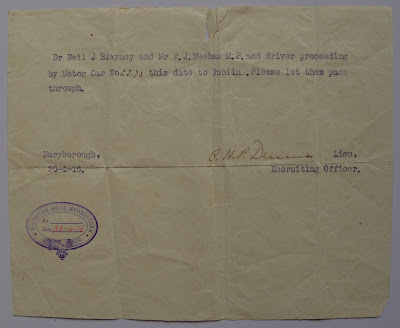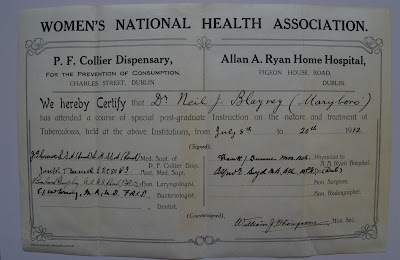The papers of Neil John Blayney (1874-1919)
This is the second in a series of guest posts by UCD MA students based on their work with the papers of Dr Neil John Blayney, you can find all the posts here. This post was written by Kirsty Lyons a student on the MA in Archives and Records Management.
Donated to RCPI by his family, the papers of Neil John Blayney (1874-1919) provide researchers the opportunity to delve into the experiences of a doctor attached to a county hospital in the early twentieth century. Donations such those made by Blayney’s family are vital for researchers as they enrich the picture of Irish medicine outside of the more famous names. This interesting collection provides a glimpse into the response of an Irish county doctor to several epoch defining events.
The donation allows researchers to reconstruct personal and professional aspects of Blayney’s life. It contains a range of information, allowing readers to imagine how Blayney furnished his home, his patients, and the illnesses he treated. It also provide colleagues’ opinions of Blayney, giving documents - found in what his grandson, Neil Brennan, described as “dusty boxes” - a human countenance. Blayney’s life also intersected watershed moments in history, namely, First World War, 1916 Easter Rising, and the 1919 Spanish influenza epidemic: documents contained in the collection reveal how Blayney met the challenges of his time.
First World War
The collection includes a letter written by Blayney to the Daily Mail. The letter identifies Blayney as a nationalist. Despite this political inclination, Blayney felt strongly about the First World War and sought to enlist in the British Army’s Royal Army Medical Corp, a request denied because there was “no urgent need . . . of medical men”.
Notwithstanding, he felt compelled to help and placed his luxury French Porthos car at the disposal of the Irish Automobile Club which they used to transfer injured soldiers between hospital and convalescent homes. Unfortunately, the car broke down and cost of fixing it became a matter of dispute between Blayney and the Club. Blayney, however, did become the Medical Officer for the local army troops and RIC members in December 1915. As Medical Officer, his worry for the men’s health during a cold and damp winter is evident as he requested additional coal for them (which was denied by the Curragh).
 |
| Letter from the War Office to Neil John Blayney (NJB/3/1/1) |
Easter Rising 1916
One of the more tantalising documents in the collection is a travel permit dated 30 April 1916. The document allowed Blayney, Patrick J. Meehan, and a driver to travel to Dublin. Patrick J. Meehan was MP for Queen’s County Leix and Blayney’s brother-in-law. In the Rising’s aftermath, the British Army positioned roadblocks around Dublin so travel required permission, the date places the permit in this timeframe. It is thought that this journey was to deliver bread to St. Vincent de Paul, Ozanam House, as there were food shortages in Dublin.
 |
| Travel pass issued to Neil J Blayney, dated 30 April 1916 (NJB/3/4) |
Infectious Diseases
Treating infectious disease was a daily and challenging aspect of Blayney’s career. Before the advent of suplhonamides and, later, penicillin, effective treatments for infections were in short supply, let alone PPE for doctors and nurses. Blayney’s first positions was as a Resident Surgeon at the Mater Infirmorum Hospital, Belfast (1898-1899), where there was a serious typhoid epidemic (1897-1898). The typhoid epidemic underlined for Blayney the importance of public health messaging. Tuberculosis was endemic in Ireland during Blayney’s life and many papers in the collection relate to the treatment and diagnosis of the disease: these pertain particularly to his role as County Surgeon at Queen’s Infirmary, Maryborough, Queen’s County (1901-1919). While Blayney was at Queen’s, a sanatorium was built for the treatment of tuberculosis through a system of subscription instigated by Lady Ellen Coote of Ballyfin House, Mountrath, Queen’s County. Fundraising began in December 1909, building commenced in September 1910 and the sanatorium was officially opened in 1911. This was a stressful period for the hospital and Blayney applied for a new position as Inspector of Reformatories and Industrial Schools. Blayney’s application was unsuccessful, and he was still at Queen’s when the sanatorium burned down in 1912.
In July 1912, Blayney attended a course arranged by the Women’s National Health Association on the nature and treatment of “consumption”. Blayney himself also gave public information lectures on the spread of tuberculosis, perhaps in remembrance of his time in Belfast and the typhoid epidemic. The prevalence of material relating to tuberculosis in the collection emphasises Blayney’s commitment to understanding the disease and best approaches to treating it. Tragically, Blayney’s career is book-ended by infectious diseases, as Blayney’s own death occurred during a deadly Spanish Influenza pandemic: Blayney died on 26 February 1919 from a stroke, a possible consequence of the Influenza.
 |
| Certificate from the Women's National Health Association issued to Neil J Blayney (NJB/1/4/3) |
Generous donations to the RCPI, like the Neil John Blayney Papers, provide an opportunity to explore the lives of doctors who might otherwise be forgotten outside of the “big names” of Irish medicine. While vital to their communities and remembered in their families, the impact of doctors who worked in smaller county hospitals is largely neglected. These collections give an insight into the operating of these county hospitals and communities, offering researchers new sources of information to mine. Essentially, through donations such as the Neil John Blayney Papers, researchers are able to reconstruct the lives and reassesses the contribution of the Irish county doctor. We hope more families are encouraged to open their “dusty boxes”!
Kirsty Lyons
MA in Archives and Records Management, UCD
You can view the full listing of the Neil John Blayney Collection on our website.
Further reading:
Alexander W. Blayney, “Review: Opening Dusty Boxes: The Life of a County Surgeon in Edwardian Ireland (2019).” Irish Medical Journal 113, no. 6 (2019): 104.
Neil Brennan, Opening Dusty Boxes: The Life of a County Surgeon in Edwardian Ireland. Cork: Lettertec Publishing, 2019.
Alan F. Carthy, “The treatment of tuberculosis in Ireland from the 1890s to the 1970: a case study of medical care in Leinster” (unpub PhD, National University of Ireland Maynooth, 2015).